Introduction[]
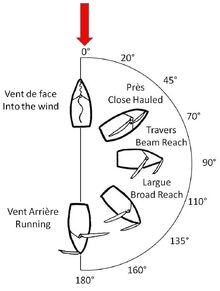
Illustration of the points of sailing
Together with the Sailing Profiles of the ships of Naval Action, the default speed value can be used to calculate the generic speed of the different vessels on different points of sail - a ship's sailing direction relative the direction of the wind. To the right is an illustration of these points. The wind is blowing from the top of the semicircle to the bottom. Sailing directly into the wind is given as a course of 0 degrees, or sailing at point 0. Close-hauled is sailing at an angle of 45 degrees relative the wind, also known as sailing at point 45. Beam Reach, Broad Reach and Running are when sailing at point 90, 135 and 180 respectively. Typically fore-and-aft rigged vessels, usually smaller one- or two-masted vessels, sail fastest between points 0 and 90. The square-rigged vessels, the larger two- or three-masted vessels sail best around point 135. Knowing where your ship is fast, and in particular where it is faster than your opponent's ship, is a very important part of commanding your ship. A graph illustrating a ship's speed along the points 0-180 (the same as points 360-180) can be produced to provide an overview to Captains of their ships' sailing speeds. Here then follows a series of graphs, sorted by type of ship, displaying the ships' speeds at different points.
It is important to bear in mind that the information below denotes the default sailing speeds of the ships. This is as a rule altered by the type of wood, sail trim, outfitting, equipment, etc., that a ship uses. For this reason, exercise judgement when using the speed graphs, and allow for relative fluctuations in combat situations.
Overview[]
As producing one comparison for all ships becomes very cluttered, there are instead a number of graphs for the different ship types beneath.
Cutters[]
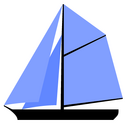
Cutter sail plan
Cutters are small single-masted vessels that are adept at sailing on a beam reach and close-hauled. In Naval Action there are currently two cutters available to sail; the Cutter and the Yacht. The Cutter will be familiar ship for all Captains as this is the starting ship in Naval Action. The Yacht, on the other hand, is a backer reward for those players that backed the game early. For this reason, as it is awarded and not constructed, all Yachts have the same set of traits - for this reason you will never encounter a Yacht that is faster or slower than the graph below depicts. So, bearing in mind that the Yacht depicted below is not the "default" value for this ship but rather the value of the Live Oak Yacht with Exceptional Speed that is given as a reward to players, note that the Yacht is faster on a beam reach, while the Cutter is faster close-hauled. Both ships, however, handle very similarly.

Graph of cutter speeds
Topsail Schooners[]
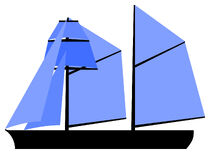
Topsail Schooner sail plan
Topsail schooners are two-masted vessels designed to be fast sailing on a beam reach or upwind. In Naval Action there are three such schooners available to sail, yet these differ significantly in their preferred points of sail. The Lynx is a very fast ship that excels sailing close-hauled or on a beam reach. It suffers heavily when trying to sail downwind, but is that ship which is fastest sailing close to the wind. The Privateer behaves similarly when sailing upwind, but is not quite as fast as the Lynx, and is not fast at all on a beam reach. Bear in mind, however, that the Privateer is more heavily armed, armoured, and crewed to balance this out. The Pickle is frequently underestimated ship that surprisingly is fast at any point beyond sailing close-hauled. While not fond of sailing closer to the wind than 45 degrees, the Pickle is a very easy ship to sail. Wise Captains make the most of her broad sailing range and can always find a point on which they can outsail pursuing opponents when needed.
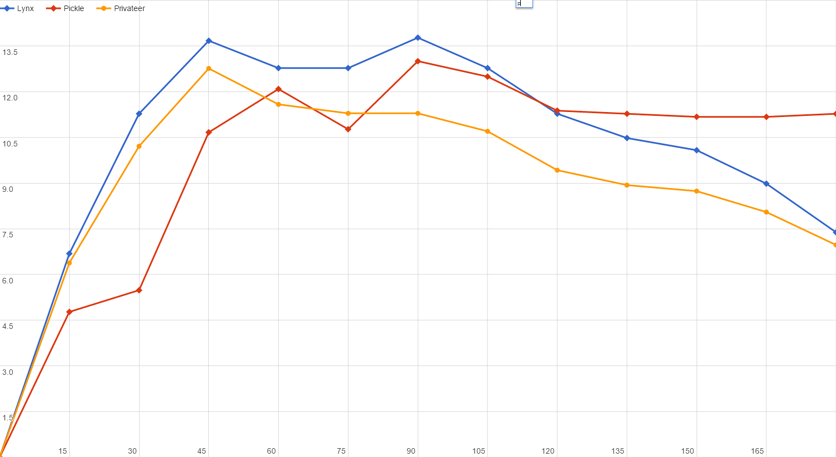
Graph of topsail schooner speeds
Snows and Brigs[]

Brig sail plan
Brigs and snows have very similar sail plans, both being two-masted square-rigged vessels. This also means that they behave similarly and have similar speed profiles - they all do best sailing on a broad reach and all suffer speed-wise when pushed upwind of a beam reach. In Naval Action there are currently four brigs and one snow. The Brig is the standard brig in the game - she sails well past a beam reach and is fastest, as all square-rigged vessels, around point 135-150.The Navy Brig is a heavier version of the Brig that behaves very similarly but is actually not slower, despite common belief of the contrary. The Niagara is a long hard-hitting brig - her strengths (relative the other brigs) are chiefly on points upwind of a beam reach. Likewise, and indeed even more so, the Mercury outpaces the other square-rigged unrated vessels when sailing upwind of a beam reach. The Snow is a uniquely forgiving square-rigged unrated vessel; she does well not only at a beam reach, but is also decently fast upwind (relative the brigs) as well as being uncommonly fast when running with the wind. These attributes grant her a subtle unpredictability in combat and are often of use when retreat is necessary. It should be noted, however, that the Snow is not, in general, a fast ship, and in particular suffers from low speeds at points 105-120.

Graph of snow and brig speeds
Frigates[]
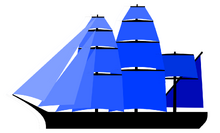
Frigate (ship-rigged) sail plan
The light frigates of Naval Action are the Cerberus, Renommee and Surprise. They are all surprisingly quick for square-rigged vessel, but in different ways. The Cerberus, often the first frigate a Captain will sail, is fast in that it performs well at a beam reach as well as being quick along a broad range of points from 105 onwards. What's more, although losing a lot of speed when sailing upwind of a beam reach, she doesn't suffer the same catastrophic loss of speed as the other frigates when coming to around 15 degrees of the wind. The Renommee is fast in a more straightforward manner; she is simply damned fast. Her high base speed compensates for her below-par Sailing Profile by granting her excellent speed at most points but extraordinarily high speeds with the wind anywhere abaft her beam. It should be noted, however, that she is not quite as fast upwind as many Captains like to think, and a prudent Renommee Captain should make note of this to avoid being pursued or trapped on these points. In general, however, the Renommee should never experience any difficulty escaping from combat, nor catching a fleeing opponent as long as the chase is downwind. The Surprise is fast in a third way - in her surprising speed upwind. Her speeds between sailing close-hauled or on a beam reach mean she can often catch unwary opponents trying to flee along these points, particularly given her armament, which includes two bow chasers. She has a low base speed, however, and this tells when sailing on a broad reach. She is simply not fast enough to catch up with many other frigates, but will have to rely on accurate fire from her bow chasers to slow fleeing enemies during prolonged chases. However, that said, she is still a pleasure to sail, as the ability to maintain decent speeds while sailing closer to the wind than a beam reach is very useful in combat situations! The Gros Ventre, despite not being a fighting frigate, is still in terms of size and rig essentially a light frigate. She is not a fast ship, however, her Sailing Profile allows for a decent speed on most points and this is her primary sailing strength. Being comfortable on most points between a beam reach and running, and being comparable even to the Surprise in terms of speed on a close haul, her chances of escape are maximized when sailing on suboptimal points for a square-rigged vessel such as, for example, close hauled or running before the wind. She is not at her fastest on these points but performs relatively better than the other frigates there.
The Frigate (and in terms of sailing identical Pirate Frigate) is a fifth rate, and more of a standard frigate than a light one. For this reason she sails very differently to the other ships. Her handling is much worse, and speed in general lower. What's more, she cannot sail at all closely to the wind and will punish the unwary Captain who brings her too close to the wind. She is considered a medium frigate together with the Belle Poule, Essex and Trincomalee which all behave similarly. All these ships have similar speeds but the Trincomalee will as a rule come out on top, followed by the Frigate, and then the Essex and Belle Poule. The Constitution is a heavy frigate and is notably different to the other frigates; she loses speed a lot more rapidly when sailing upwind and severely punishes Captains who push her past a beam reach. Her top speed is very limited and in general she is difficult to sail in such a manner as to maintain decent speeds. In particular, sailing anywhere near a beam reach, even more "upwind" than point 105 will slow her progress severely. The one strength the Constitution has is her performance sailing with the wind directly behind her; on this point her relative performance will see her generate enough speed to potentially catch (or outrun) the other frigates.

Graph of the sailing speeds of the frigates
